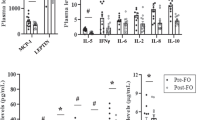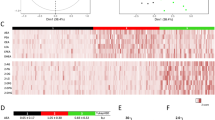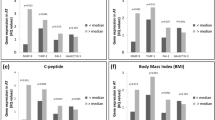Abstract
Context:
Endocannabinoids (ECs) have a role in obesity by affecting appetite and through peripheral effects. Obesity is associated with a dysregulation of the endocannabinoid system (ECS).
Objective:
We aimed to determine the ECS in subcutaneous adipose tissue (AT) in obese subject and investigate the influence of diet-induced weight loss on this system.
Design:
The obese study participants underwent a 12 weeks diet regimen resulting in 10–12% weight loss. All study participants underwent fasting blood samples and AT biopsies from abdomen and gluteal region, the obese subjects both before and after weight loss.
Setting and participants:
A total of 21 healthy obese individuals (10 men/11 women, age 39.5±1.6 years, body mass index (BMI): 37.5±0.8 kg m−2) and 21 age- and gender-matched lean subjects (BMI: 23.8±0.4 kg m−2) were studied.
Main outcome measures:
The activity of ECS in AT was determined by measuring arachidonoyl glycerol (2-AG) and N-arachidonoylethanolamine/anandamide in AT by mass spectrometry and gene expressions of enzymes and receptors involved in the ECS.
Results:
The EC, 2-AG was reduced in obese individuals in the gluteal AT depot (P<0.01). Moreover, 2-AG increased in both depots in the obese subjects following weight loss (P<0.05). The gene expression of the CB1 was either not affected by the obese state (in the gluteal AT depot) or reduced (in the abdominal depot, P<0.05) and significantly affected by weight loss. The expression of the degrading enzymes FAAH, FAAH2, MGL and MGL2 was differently affected by obesity, AT depot and weight loss.
Conclusion:
We found reduced levels of 2-AG in subcutaneous AT in obesity, which increased after weight loss. In abdominal AT, the low CB1 expression was normalised after weight loss, whereas in gluteal AT the CB1 expression was reduced after weight loss. These findings support the concept of a dysregulated ECS in AT in association with obesity.
This is a preview of subscription content, access via your institution
Access options
Subscribe to this journal
Receive 12 print issues and online access
$259.00 per year
only $21.58 per issue
Buy this article
- Purchase on Springer Link
- Instant access to full article PDF
Prices may be subject to local taxes which are calculated during checkout



Similar content being viewed by others
References
Engeli S, Bohnke J, Feldpausch M, Gorzelniak K, Janke J, Batkai S et al. Activation of the peripheral endocannabinoid system in human obesity. Diabetes 2005; 54: 2838–2843.
Bluher M, Engeli S, Kloting N, Berndt J, Fasshauer M, Batkai S et al. Dysregulation of the peripheral and adipose tissue endocannabinoid system in human abdominal obesity. Diabetes 2006; 55: 3053–3060.
Cote M, Matias I, Lemieux I, Petrosino S, Almeras N, Despres JP et al. Circulating endocannabinoid levels, abdominal adiposity and related cardiometabolic risk factors in obese men. Int J Obes (Lond) 2007; 31: 692–699.
Sipe JC, Scott TM, Murray S, Harismendy O, Simon GM, Cravatt BF et al. Biomarkers of endocannabinoid system activation in severe obesity. PLoS ONE 2010; 5: e8792.
Maccarrone M, Gasperi V, Catani MV, Diep TA, Dainese E, Hansen HS et al. The endocannabinoid system and its relevance for nutrition. Ann Rev Nutr 2010; 30: 423–440.
Sarzani R, Bordicchia M, Marcucci P, Bedetta S, Santini S, Giovagnoli A et al. Altered pattern of cannabinoid type 1 receptor expression in adipose tissue of dysmetabolic and overweight patients. Metabolism 2009; 58: 361–367.
Di Marzo V . The endocannabinoid system in obesity and type 2 diabetes. Diabetologia 2008; 51: 1356–1367.
Bordicchia M, Battistoni I, Mancinelli L, Giannini E, Refi G, Minardi D et al. Cannabinoid CB1 receptor expression in relation to visceral adipose depots, endocannabinoid levels, microvascular damage, and the presence of the Cnr1 A3813G variant in humans. Metabolism 2010; 59: 734–741.
Pertwee RG, Howlett AC, Abood ME, Alexander SPH, Di Marzo V, Elphick MR et al. International Union of Pharmacology. Cannabinoid Receptors and their Ligands: Beyond CB1 and CB2 . Pharmacol Rev 2010; 62: 588–631.
Lauckner JE, Jensen JB, Chen HY, Lu HC, Hille B, Mackie K . GPR55 is a cannabinoid receptor that increases intracellular calcium and inhibits M current. Proc Natl Acad Sci USA 2008; 105: 2699–2704.
Matias I, Di Marzo V . Endocannabinoid synthesis and degradation, and their regulation in the framework of energy balance. J Endocrinol Invest 2006; 29 (3 Suppl): 15–26.
Howlett AC, Barth F, Bonner TI, Cabral G, Casellas P, Devane WA et al. International Union of Pharmacology. XXVII. Classification of cannabinoid receptors. Pharmacol Rev 2002; 54: 161–202.
Roche R, Hoareau L, Bes-Houtmann S, Gonthier MP, Laborde C, Baron JF et al. Presence of the cannabinoid receptors, CB1 and CB2, in human omental and subcutaneous adipocytes. Histochem Cell Biol 2006; 126: 177–187.
Ahn K, McKinney MK, Cravatt BF . Enzymatic pathways that regulate endocannabinoid signaling in the nervous system. Chem Rev 2008; 108: 1687–1707.
Sugiura T, Kishimoto S, Oka S, Gokoh M . Biochemistry, pharmacology and physiology of 2-arachidonoylglycerol, an endogenous cannabinoid receptor ligand. Prog Lipid Res 2006; 45: 405–446.
Hansen HS, Diep TA . N-acylethanolamines, anandamide and food intake. Biochem Pharmacol 2009; 78: 553–560.
De Petrocellis L, Di Marzo V . An introduction to the endocannabinoid system: from the early to the latest concepts. Best Pract Res Clin Endocrinol Metab 2009; 23: 1–15.
Kirkham TC, Tucci SA . Endocannabinoids in appetite control and the treatment of obesity. CNS Neurol Disord Drug Targets 2006; 5: 272–292.
Rosenson RS . Role of the endocannabinoid system in abdominal obesity and the implications for cardiovascular risk. Cardiology 2009; 114: 212–225.
Greenberg I, Kuehnle J, Mendelson JH, Bernstein JG . Effects of marihuana use on body weight and caloric intake in humans. Psychopharmacology (Berl) 1976; 49: 79–84.
Williams CM, Kirkham TC . Anandamide induces overeating: mediation by central cannabinoid (CB1) receptors. Psychopharmacology (Berl) 1999; 143: 315–317.
Curioni C, Andre C . Rimonabant for overweight or obesity. Cochrane Database Syst Rev 2006; CD006162.
Bennetzen MF, Nielsen TS, Paulsen SK, Bendix J, Fisker S, Jessen N et al. Reduced cannabinoid receptor 1 protein in subcutaneous adipose tissue of obese. Eur J Clin Invest 2010; 40: 121–126.
Jbilo O, Ravinet-Trillou C, Arnone M, Buisson I, Bribes E, Peleraux A et al. The CB1 receptor antagonist rimonabant reverses the diet-induced obesity phenotype through the regulation of lipolysis and energy balance. FASEB J 2005; 19: 1567–1569.
Pagano C, Pilon C, Calcagno A, Urbanet R, Rossato M, Milan G et al. The endogenous cannabinoid system stimulates glucose uptake in human fat cells via phosphatidylinositol 3-kinase and calcium-dependent mechanisms. J Clin Endocrinol Metab 2007; 92: 4810–4819.
Christiansen T, Paulsen SK, Bruun JM, Ploug T, Pedersen SB, Richelsen B . Diet-induced weight loss and exercise alone and in combination enhance the expression of adiponectin receptors in adipose tissue and skeletal muscle, but only diet-induced weight loss enhanced circulating adiponectin. J Clin Endocrinol Metab 2010; 95: 911–919.
Matthews DR, Hosker JP, Rudenski AS, Naylor BA, Treacher DF, Turner RC . Homeostasis model assessment: insulin resistance and beta-cell function from fasting plasma glucose and insulin concentrations in man. Diabetologia 1985; 28: 412–419.
Systéme International (SI) units for plasma, serum, or blood concentrations. Diabetes 1993; 42: 370–371.
Artmann A, Petersen G, Hellgren LI, Boberg J, Skonberg C, Nellemann C et al. Influence of dietary fatty acids on endocannabinoid and N-acylethanolamine levels in rat brain, liver and small intestine. Biochim Biophys Acta 2008; 1781: 200–212.
Matias I, Gonthier MP, Orlando P, Martiadis V, De PL, Cervino C et al. Regulation, function, and dysregulation of endocannabinoids in models of adipose and beta-pancreatic cells and in obesity and hyperglycemia. J Clin Endocrinol Metab 2006; 91: 3171–3180.
Starowicz KM, Cristino L, Matias I, Capasso R, Racioppi A, Izzo AA et al. Endocannabinoid dysregulation in the pancreas and adipose tissue of mice fed with a high-fat diet. Obesity (Silver Spring) 2008; 16: 553–565.
Izzo AA, Piscitelli F, Capasso R, Aviello G, Romano B, Borrelli F et al. Peripheral endocannabinoid dysregulation in obesity: relation to intestinal motility and energy processing induced by food deprivation and re-feeding. Br J Pharmacol 2009; 158: 451–461.
Bensaid M, Gary-Bobo M, Esclangon A, Maffrand JP, Le FG, Oury-Donat F et al. The cannabinoid CB1 receptor antagonist SR141716 increases Acrp30 mRNA expression in adipose tissue of obese fa/fa rats and in cultured adipocyte cells. Mol Pharmacol 2003; 63: 908–914.
Annuzzi G, Piscitelli F, Di Marino L, Patti L, Giacco R, Costabile G et al. Differential alterations of the concentrations of endocannabinoids and related lipids in the subcutaneous adipose tissue of obese diabetic patients. Lipids Health Dis 2010; 9: 43.
Engeli S, Heusser K, Janke J, Gorzelniak K, Batkai S, Pacher P et al. Peripheral endocannabinoid system activity in patients treated with sibutramine. Obesity (Silver Spring) 2008; 16: 1135–1137.
Di Marzo V, Cote M, Matias I, Lemieux I, Arsenault BJ, Cartier A et al. Changes in plasma endocannabinoid levels in viscerally obese men following a 1 year lifestyle modification programme and waist circumference reduction: associations with changes in metabolic risk factors. Diabetologia 2009; 52: 213–217.
Di Marzo V, Maccarrone M . FAAH and anandamide: is 2-AG really the odd one out? Trends Pharmacol Sci 2008; 29: 229–233.
Engeli S, Bohnke J, Feldpausch M, Gorzelniak K, Janke J, Batkai S et al. Activation of the peripheral endocannabinoid system in human obesity Diabetes 2005; 54: 2838–2843.
Acknowledgements
We thank all study participants. We greatly appreciate the excellent technical assistance of Lenette Pedersen and Pia Hornbek, Department of Endocrinology, Aarhus University Hospital. The study was supported by the Danish Medical Research Council, Aarhus University, Danish Obesity Research Centre, DanORC (Danish Strategic Research Council), and by the UNIK project: Food, Fitness, and Pharma.
Author information
Authors and Affiliations
Corresponding author
Ethics declarations
Competing interests
The authors declare no conflict of interest.
Rights and permissions
About this article
Cite this article
Bennetzen, M., Wellner, N., Ahmed, S. et al. Investigations of the human endocannabinoid system in two subcutaneous adipose tissue depots in lean subjects and in obese subjects before and after weight loss. Int J Obes 35, 1377–1384 (2011). https://doi.org/10.1038/ijo.2011.8
Received:
Revised:
Accepted:
Published:
Issue Date:
DOI: https://doi.org/10.1038/ijo.2011.8
Keywords
This article is cited by
-
The association of dietary patterns with endocannabinoids levels in overweight and obese women
Lipids in Health and Disease (2020)
-
Whey protein supplementation reducing fasting levels of anandamide and 2-AG without weight loss in pre-menopausal women with obesity on a weight-loss diet
Trials (2020)
-
Effect of whey protein supplementation on levels of endocannabinoids and some of metabolic risk factors in obese women on a weight-loss diet: a study protocol for a randomized controlled trial
Nutrition Journal (2017)
-
Gene expression of the zinc transporter ZIP14 (SLC39a14) is affected by weight loss and metabolic status and associates with PPARγ in human adipose tissue and 3T3-L1 pre-adipocytes
BMC Obesity (2015)



